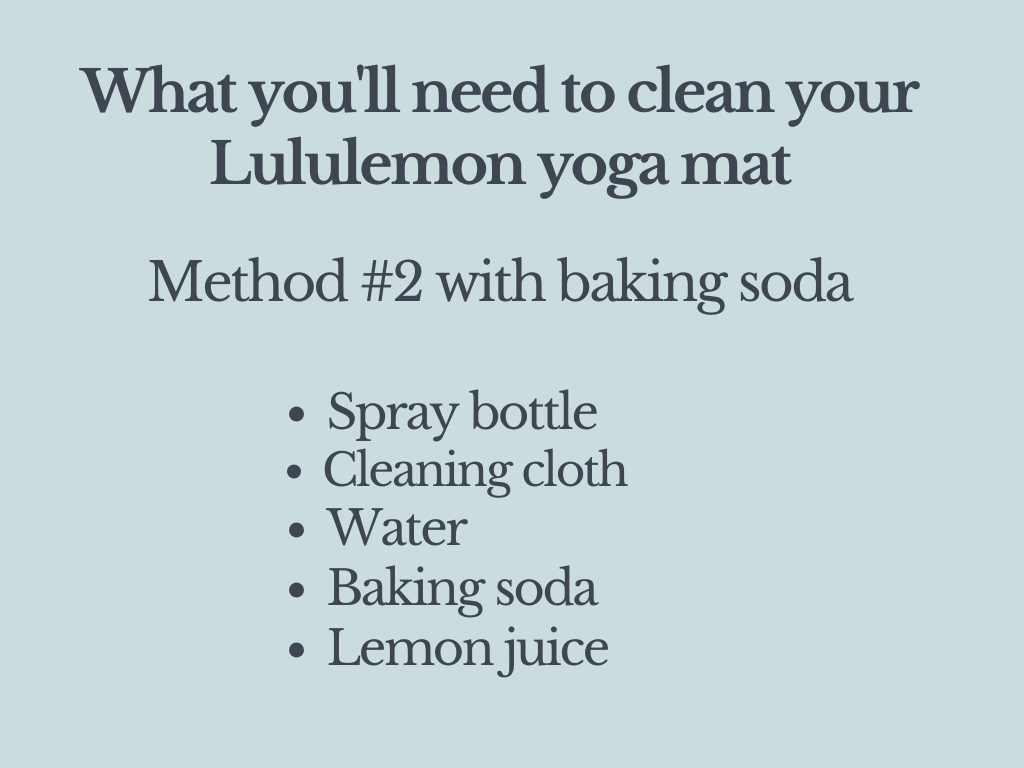How To Clean A Lululemon Yoga Mat
Keeping your Lululemon yoga mat clean is essential for maintaining its performance, longevity, and hygiene. Regular cleaning not only removes dirt, sweat, and bacteria but also ensures your mat remains grippy and fresh for every practice. Lululemon mats, with their polyurethane top surface and rubber base, require specific cleaning techniques to avoid damage and preserve their quality.
In this comprehensive guide, we’ll explore three effective methods to clean your Lululemon yoga mat using simple, safe ingredients. Whether you prefer essential oils, baking soda, or mild soap, these methods are designed to keep your mat in top condition. Let’s dive in!
Why It’s Important to Clean Your Lululemon Yoga Mat
Hygiene: Sweat, dirt, and oils accumulate over time, leading to bacteria and unpleasant odors.
Performance: A clean mat maintains its grip, which is crucial for balance and stability during practice.
Longevity: Proper care prevents wear and tear, extending the life of your mat.
What Is a Lululemon Yoga Mat Made Of?
Lululemon yoga mats are crafted with specific materials that influence how they should be cleaned:
Polyurethane Top Surface: Absorbs sweat for a grippy, non-slip surface.
Rubber Base: Provides cushioning and support.
Material Composition (as listed by Lululemon):
55% Natural Rubber
23% Synthetic Rubber
15% Polyurethane
5% Polyester
2% Nylon
Care Instructions (as per Lululemon):
Ensure the mat is dry before rolling.
Store it out of direct sunlight.
Wipe clean with a damp cloth.
The mat also contains a biocidal treatment to inhibit bacteria and mold, but regular cleaning is still essential for optimal performance.
Method 1: Essential Oils
This method is ideal for regular maintenance and light cleaning. Essential oils like tea tree oil have natural antibacterial properties, making this an effective and refreshing way to clean your mat.
What You’ll Need:
Spray bottle
Cleaning cloth or microfiber towel
Water
White vinegar
Tea tree oil
Instructions:
Prepare the Solution:
Fill a spray bottle with 1 part white vinegar and 3 parts water.
Add 3–5 drops of tea tree oil for its antibacterial and antifungal properties.
Spray the Mat:
Lightly mist the solution over the surface of your mat. Avoid soaking it, especially the rubber base.
Wipe Down:
Use a clean cloth or microfiber towel to gently wipe the surface, removing sweat, dirt, and oils.
Dry:
Allow the mat to air dry completely before rolling it up or storing it.
Method 2: Baking Soda and Lemon Juice
This method is excellent for deep cleaning and odor removal. Baking soda neutralizes odors, while lemon juice provides natural antibacterial and cleansing properties.
What You’ll Need:
Spray bottle
Cleaning cloth or sponge
Water
Baking soda
Lemon juice
Instructions:
Mix the Solution:
Combine 1 tablespoon of baking soda with 1 cup of water in a spray bottle.
Add 1–2 tablespoons of lemon juice for a fresh, clean scent. Shake well to mix.
Apply to the Mat:
Spray the solution evenly across the mat’s surface.
Scrub Gently:
Use a damp sponge or cloth to scrub the mat gently, focusing on any visible stains or dirt.
Rinse and Wipe:
Wipe the mat with a clean, damp cloth to remove any residue.
Dry Thoroughly:
Air dry the mat completely before rolling it up.
Method 3: Mild Soap
For a thorough clean after a particularly sweaty session or intense practice, this method is highly effective. It’s gentle yet powerful enough to tackle dirt and bacteria.
What You’ll Need:
Basin or sink
Sponge or soft cloth
Warm water
Mild dish soap
Instructions:
Prepare the Soapy Water:
Fill a basin or sink with warm water and add a few drops of mild dish soap.
Wash the Mat:
Dip a sponge or cloth into the soapy water and gently scrub the mat’s surface. Pay attention to high-use areas like where your hands and feet typically rest.
Rinse:
Wipe the mat with a clean, damp cloth to remove soap residue. Avoid submerging the mat entirely, as it can damage the rubber base.
Dry:
Lay the mat flat or hang it to air dry. Ensure it’s fully dry before storing it.
Additional Tips for Maintaining Your Lululemon Yoga Mat
Wipe Down After Each Use:
Use a damp cloth or a ready-made mat cleaner to quickly clean the mat after every session.
Avoid Harsh Chemicals:
Bleach, alcohol-based cleaners, and abrasive scrubbing can damage the polyurethane surface and rubber base.
Store Properly:
Keep your mat in a cool, dry place, away from direct sunlight, which can degrade the materials over time.
Test Cleaning Solutions:
Always test new cleaning solutions on a small area of the mat before applying them fully.
Clean Regularly:
For frequent practitioners, aim to deep clean your mat every 1–2 weeks. Occasional users can clean their mat monthly.
Why Proper Cleaning Matters
Lululemon yoga mats are an investment, and regular care ensures they remain in optimal condition. Proper cleaning prevents the buildup of bacteria and odors while maintaining the mat’s grip and durability. A well-maintained mat not only enhances your practice but also supports your health and hygiene.
Common Questions About Cleaning a Lululemon Yoga Mat
Can I Use Disinfectant Wipes?
It’s best to avoid harsh disinfectant wipes as they may damage the mat’s surface. Stick to gentle cleaning solutions.
Can I Put My Mat in the Washing Machine?
No, Lululemon mats should not be machine washed, as it can compromise their materials.
How Often Should I Clean My Mat?
Wipe it down after each use and deep clean every 1–2 weeks if you practice frequently.
Conclusion
Cleaning your Lululemon yoga mat is essential for preserving its quality, hygiene, and performance. Whether you prefer the natural freshness of essential oils, the deep-cleaning power of baking soda and lemon juice, or the simplicity of soap and water, these methods will keep your mat in top shape.
By incorporating regular cleaning into your routine and following Lululemon’s care guidelines, you can enjoy a clean, grippy mat that supports your practice for years to come.



